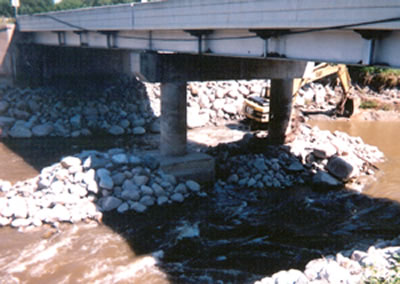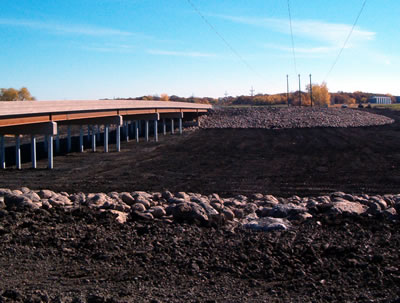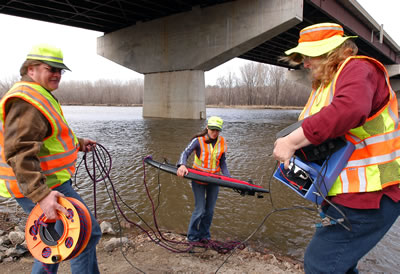|
By Craig Wilkins

A contractor placed piles of riprap to help prevent further damage to the piers and embankments of the Hwy 32 bridge over the Wild Rice River near Twin Valley. Photo by Davis Holthusen
|
“That’s so much water under the bridge,” people often say casually to describe events that already have happened.
But in a literal sense, keeping ‘water under the bridge’ is serious business for Mn/DOT’s bridge construction and maintenance crews.
Nearly every spring, flooding rivers hurl thousands of tons of water, tree trunks, massive chunks of ice and other debris at the state’s bridges.
Even when they’re not in flood situations, the state’s rivers still pose a constant challenge to the people who design, build and maintain them.
Moving water erodes embankments, piers and abutments, and can dislodge (or scour) silt around bridge piers and weaken bridges from the flow’s force.
Minnesota has more than 4,500 over-water bridges on state highways.
“Bridges create obstacles and obstacles affect the flow of water,” said Tom Styrbicki, preliminary bridge plans engineer with the Bridge Office.
He said the Bridge Office uses reports from district bridge crews, calculations of the volume and velocity of water flow and other analyses from staff to determine corrective action for an existing bridge or the criteria to be met when designing a new one. Bridge Office staff conduct on-site visits and confer with district operations staff regularly to decide on needed actions.
Working with Bemidji/District 2, for example, Bridge Office staff and district officials have taken several measures to reduce flooding in the flat, flood-prone expanses of northwestern Minnesota .

The new bridge at St. Vincent carries Hwy 171 over an area frequently inundated by overland flooding from the Red River of the North. Photo by Davis Holthusen |
Last year, the district replaced a box culvert on Hwy 171 at St. Vincent with a new bridge. The bridge spans a creek bed that, during flood season, collected overland floodwaters from the Red River of the North and frequently flooded the highway.
Now, the 518-foot-long bridge, with its higher elevation and wide opening, keeps floodwaters away from the highway and creates a channel to drain the water before it can pool and flood the area.
This year, District 2 will build a new bridge on Hwy 32 over the Wild Rice River near Twin Valley .
J. T. Anderson, resident engineer at Thief River Falls, said heavy rains caused severe flooding there in 2003. The river washed out the downstream dam that had been keeping the water level bridge-high, thereby reducing the speed of the water through the bridge. When the dam’s embankment failed, the water level was lowered at the bridge, creating high velocities and causing severe scouring to exposed parts of the structure’s piers.
The new bridge will have no piers and will be a single-span structure.
Not every bridge warrants replacement.
Other measures include protecting piers and embankments with riprap (piles of large boulders placed to reduce the water’s flow rate) and building spur dikes to alter currents that pose a danger to bridge piers and pilings.

Dan Prather, Maria Lobo de Murphy and Petra DeWall from the Bridge Office at Oakdale prepare to launch a device that measures data such as river depths and flow rates at the Interstate 35W bridge over the Minnesota River in Bloomington. Photo by David Gonzalez |
Petra DeWall, a hydraulics engineer with the Bridge Office, said the spur dikes (large piles of rock covered with vegetation) can redirect a river’s flow to avoid hitting piers at sharp angles that could cause severe scouring and other damage.
Other methods, DeWall said, include building weirs (small concrete dams) and permeable dams (X-shaped members placed in the water that allow water to pass through but collect silt) and other materials that could affect the water’s flow.
Roger Hille, District 2 bridge engineer, said Bridge Office staff members “always provide the support that we need.”
Hille said he looks forward to the district’s next major bridge project: replacing the 1950s vintage through-truss style bridge that carries Hwy 11 over the Red River of the North between Drayton, N.D., and Robbin, Minn., which is scheduled to start in 2009.
The new 4,000 feet long span will replace the much shorter existing bridge and reduce the effects from the oft-flooded river. The new bridge, he said, will also ensure passage between the two states when floods occur.
“This project will involve the Bridge Office, our district and the North Dakota DOT,” Hille said. “North Dakota will design it, we’ll review the plans and each state will pay half of the new structure’s cost.”
|



